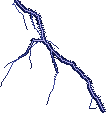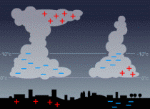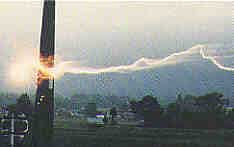2st
PART
In cumulonimbus ice crytals and water droplets are jostled by the intense vertical air. These elements collide and cause a separation of charge. Smaller particles are positively charged, back up to the top of the cloud while the heavier nuclei and the negative charges down. The soil is then negatively charged by the water droplets and ice balls. The cloud is gradually charged with energy. When the accumulation of energy becomes too large and especially when there is direct opposition between these charges then produces an electrical discharge, the lightning. The main discharge from the cloud to the ground or another cloud creates an ionized channel (under the effect of electric charges, the air mass becomes slightly conductive) invisible called stepped leader. It branches before touching the ground or another cloud after 1/100 second while moving to about 0,12 miles per second (200 m/s). Then by successive leaps, lightning pilot, kind of filled core of electrons, goes to ground or the other cloud of positive charge by browsing the most intensive charge. At the end of last decametres of path, a discharge from a point of the cloud or the ground (other similar core) positive charge goes to meet it. When the link between the two nuclei takes place, the main discharge occurs (visible), a current from the ground or to the positive source to the cloud with negative charges. This positive charge spreads extremely quickly. The heat, 54.032ºF (30.000°C), is 5 times the temperature of the Sun and up to 100 million volts, excites air molecules that emit light by releasing this energy surplus. There can be several return discharges into a ligtning, an average of 3 or 4 with 40 and 80 milliseconds between each discharge. Lightning strokes can bridge distances of 0,06 to at least 12,42 miles (100 m to at least 20 km) in the case of the sinuous lightning with a thickness of only 1-2 inches (3 cm) approximately. They can spread at a speed of 24.854,85 miles pers second (40.000 km/s).
Click here to enlarge this animation Lightning can also be caused by the friction of the particles found in the ash cloud during volcanic eruptions. They can also be created during heavy snow fall for the same reason but this is quite rare.
As can be seen all the lightnings haven't the same appearance. There are 3 types of lightnings depending on their shape.
But it is said that there is a lightning-shaped ball rare and little known : Ball lightning is a luminous sphere of a diameter of about
20 to 40 cm which appears during thunderstorms and which disappears,
or quietly or violently. Witness have even said it would enter
in houses or airplanes for a few seconds. Ball lightning is
a color ranging from yellow to orange from green to blue see
and temperature could reach 17.565,93°F
(9.726,85°C) from the reports
of burns caused by ball lightning. According to research ball
lightning is a highly ionized plasma. Smirnov has been hypothesized
that the fireball could contain sodium-rich particles and
or potassium which would be heated by the chemical reaction,
would emit photons corresponding to certain transitions. So
that would explain why it has been observed balls of various
colors : they correspond to chemical compositions and different
combustion temperatures.
Color lightnings can inform us of the composition of the ambient air of the thunderstorm:
|
 .............
.............




